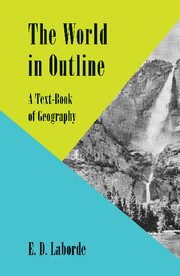Book contents
- Frontmatter
- Preface
- Contents
- PLATES
- PART I EUROPE
- PART II ASIA
- PART III AFRICA
- PART IV NORTH AMERICA
- PART V SOUTH AMERICA
- PART VI AUSTRALIA, NEW ZEALAND, AND THE PACIFIC ISLANDS
- Australia
- Human Geography
- New Zealand
- Human Geography
- The Pacific Islands
- Appendix: An Outline of Physical Geography
- Index of Place-Names
- General Index
Human Geography
from PART VI - AUSTRALIA, NEW ZEALAND, AND THE PACIFIC ISLANDS
Published online by Cambridge University Press: 05 June 2016
- Frontmatter
- Preface
- Contents
- PLATES
- PART I EUROPE
- PART II ASIA
- PART III AFRICA
- PART IV NORTH AMERICA
- PART V SOUTH AMERICA
- PART VI AUSTRALIA, NEW ZEALAND, AND THE PACIFIC ISLANDS
- Australia
- Human Geography
- New Zealand
- Human Geography
- The Pacific Islands
- Appendix: An Outline of Physical Geography
- Index of Place-Names
- General Index
Summary
Exploration. The settlement made at Sydney in 1788 soon spread over the narrow coast strip, and adventurous colonists began to make their way westwards. Fortunately, the aboriginal natives were too few to be much of an obstacle to this expansion; but the crossing of the Eastern Highlands gave some trouble, and it was not until 1813 that the divide was crossed by Gregory Blaxland, who discovered the grass plains of New South Wales. Other explorers followed at once, and in 1824 Hamilton Hume made his way across the Murrumbidgee and over the Victorian Highlands to Port Phillip. It was now supposed that there must be a large inland sea in the interior, since the westward-flowing Murrumbidgee and Lachlan seemed too big to end in salt pans and since no large river mouth had been discovered, though the continent had been circumnavigated by Flinders in 1803. To put this theory to the test, Captain Charles Sturt dragged a boat across the divide in 1829, sailed down the Murrumbidgee into the Murray, discovered the Darling, and finally reached the mouth of the river at Lake Alexandrina. In 1844 another journey of Sturt's and the work of Mitchell in the following year completed the framework of exploration in the southeast.
On the foundation of the colony of South Australia in 1834 a period of vigorous pioneering set in, and many expeditions were made in search of the best farm land. The most important of these journeys was that of John MacDougall Stuart who in 1858-62 crossed the continent from Adelaide along approximately the line of the modern overland telegraph. Burke and Wills also crossed the continent in I860, losing their lives on their return journey. The expedition achieved little in itself, but much exploration was carried out by the parties sent to look for Burke and Wills. Meanwhile, Gregory had explored Queensland, and Edward Eyre had added the Lake Torrens district to the map. Since 1870 the great western region has been steadily opened up, the most important names connected with the work being those of Forrest, Giles, and Wells.
- Type
- Chapter
- Information
- The World in OutlineA Text-Book of Geography, pp. 451 - 466Publisher: Cambridge University PressPrint publication year: 2013



